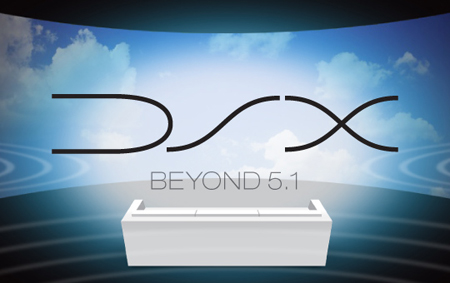Audyssey DSX

DSX stands for Dynamic Surround Expansion. In addition to the standard 5.1 channels of most home-theater systems, it will provide the option of adding up to six additional full-range channels. Ideally, these extra channels would be discretethat is, separate, independent channels in the source content. But there's no such content available at this time, so DSX derives the added channels using advanced digital signal processing. No artificial "enhancements," such as delays or added reverb, are involved.
The extra channels are called Left and Right Wide, Height, and Back Surround, and each requires its own speaker. The Wide speakers should be located at ±60 degrees from the centerthat is, well outside the main L/R speakers but still in front of the listener. The Height speakers should also be located outside the main L/Rs at an angle of ±45 degrees, and they should be raised above the plane of the other main speakers at a vertical angle of 45 degrees. The placement of the two Back Surround speakers is not well defined, but they should be directly behind the listeners.
Why add these channels? Audyssey's extensive research clearly indicates that human perception of directionality is much more precise in front of the listener than behind. Thus, expanding 5.1 to 7.1 by adding back-surround speakers is not nearly as effective as adding speakers in the front. According to Audyssey's findings, adding the Wide speakers is the most effective at increasing the sense of envelopment, followed by the Height speakers. Adding Back Surround speakers is the least effective because our sense of directionality is relatively poor to the rearin fact, a single Back Surround speaker works perfectly well.
A demonstration this week at Audyssey's facilities in Los Angeles definitely showed the effectiveness of the system. Whether or not a significant number of consumers will want to set up 11 speakers in their system (plus one or more subs) remains to be seen. But the user can opt to use only part of the system's full capabilities, perhaps adding more channels at a later date. As indicated earlier, for a partial DSX setup, adding the Wide channels provides the single greatest enhancement, followed by the Height channels and, finally, Back Surround.
We should begin seeing products that incorporate DSX by the fall of this year. No manufacturers or models were specifically mentioned, but since DSX is intended for use with Audyssey's existing equalization technologies, expect them to come from companies currently using Audyssey processing.
The first DSX products will likely be derived from existing 7.1-channel models. For example, in a DSX-capable 7.1-channel A/V receiver, the user will have the option of assigning channels 6 and 7 to Wide, Height, or Back Surround speakers. Some receivers might also offer preamp outputs for the additional channels. Users who want a full 10.1-channel setup can then add external amps to drive the extra speakers.
























































